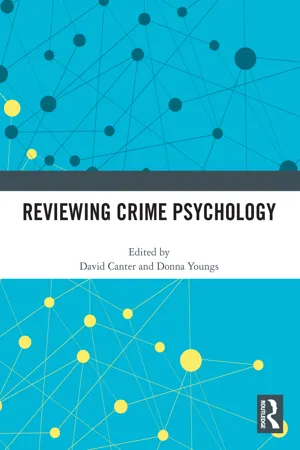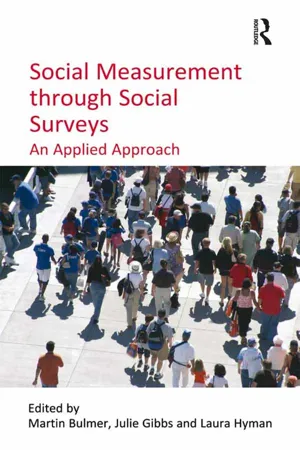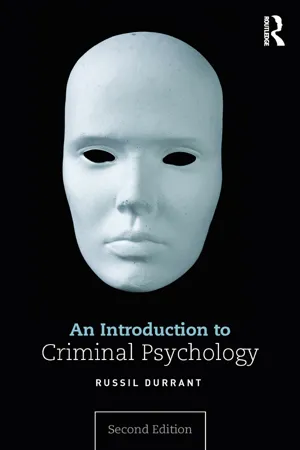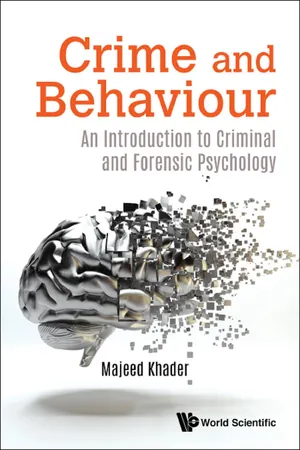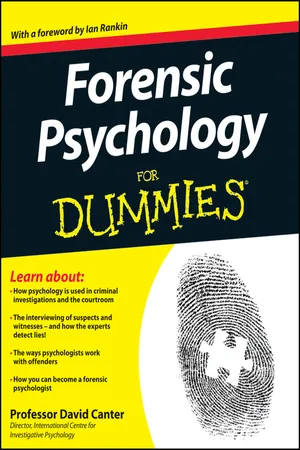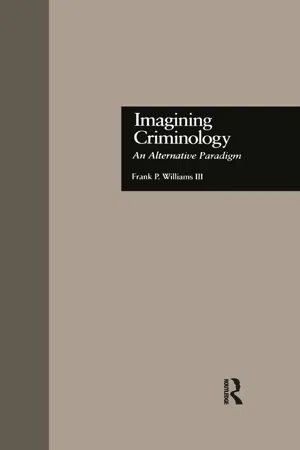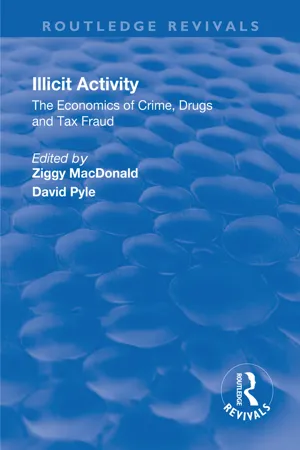Psychology
Measuring Crime
Measuring crime involves quantifying the occurrence and prevalence of criminal activities within a given population. This process often includes the use of various statistical methods and data collection techniques to assess the frequency and types of criminal behavior. By measuring crime, psychologists can better understand the nature and extent of criminal activities, which can inform the development of effective interventions and policies.
Written by Perlego with AI-assistance
Related key terms
8 Key excerpts on "Measuring Crime"
- eBook - ePub
- David Canter, Donna Youngs, David Canter, Donna Youngs(Authors)
- 2020(Publication Date)
- Routledge(Publisher)
In studying crime, researchers struggle with a variable that is inherently difficult to measure (Osgood, McMorris, & Potenza, 2002). Nevertheless, researchers have developed multiple ways of measuring delinquency and criminal conduct, giving rise to the criminological knowledge that is essential in all developed societies (e.g. crime statistics, criminal careers, risk factors, intervention effectiveness, etc.). Unfortunately, current measures of crime are recognized as being deeply flawed, and it has become a common practice in criminological studies to attach warning labels about potential validity problems and to point out that different methods may result in different estimates of crime (Enzmann, 2013).In this article, we present the major issues in Measuring Crime, a brief historical overview of the development of measurement techniques and a review of the primary methods of measuring criminal conduct. In describing these different methodologies, we will consider the advantages and limitations of each method, in order to achieve a broad and integrated understanding about crime and delinquency methods of measurement.Definition and units of measurement
The generally accepted definition of crime seems to be a legal definition: ‘any act committed in violation of a law that prohibits it and authorizes punishment for its commission’ (Wilson & Herrnstein, 1985, p. 22). However, this definition presents several problems; for example, laws have to be understood in time and space. Because laws are subject to change, many behaviours that were classified as crimes 20 years ago may not be considered as crimes today, and vice versa. Moreover, since laws are the subject of political decisions, what is considered crime in one country may not be viewed as crime in another, which is a potential limitation for comparative research between different countries. For example, in Portugal, the acquisition, possession, and use of small quantities of drugs were decriminalized in 2001 (Greenwald, 2009). Although drug usage is still prohibited, no punishment is applied, so drug usage is not a crime in Portugal. As a result, this might constitute a source of bias when comparing criminal records between Portugal and other countries where drug usage is a crime, as well as within Portugal before and after 2001. - eBook - ePub
Social Measurement through Social Surveys
An Applied Approach
- Julie Gibbs, Martin Bulmer(Authors)
- 2016(Publication Date)
- Routledge(Publisher)
Chapter 3Measuring Crime Ian Brunton-Smith and Jonathan AllenMeasures of the extent of crime provided by social surveys have become a central part of criminal statistics in the UK, offering an alternative picture of crime to police recorded crime figures and court statistics. These survey-based methods have painted a very different picture of crime, suggesting it is considerably more widespread than official measures would indicate, and have significantly advanced criminological theory and government policy. Yet despite the advances that have been made as a result of a crime survey approach, public confidence in these alternative sources of criminal statistics has recently begun to slide. Shifting definitions of different offences, and the proximity of those collecting data to the government, has led people to question their value as independent counts of crime, or the extent that they can provide consistent information over time. This loss of confidence prompted the commissioning of two independent review panels to assess the accuracy of existing survey measures, and how to improve them to raise public confidence (Smith, 2006; Statistics Commission, 2006). Since their completion, these independent reviews have heralded the extension of the British Crime Survey to under 16s, and led to renewed efforts to maximize comparability with recorded crime figures. Crime surveys, then, remain firmly in the public gaze, with their methods continuing to fall under intense scrutiny. This makes it essential for researchers to understand the methods employed and the rationale behind their introduction, but also the limitations with this type of approach and how these can impact on the types of measure produced.In this chapter we provide an overview of the survey-based methods of counting crime, looking both at victimization surveys and self-reported offending surveys. These survey-based methods are discussed within the broader historical and social context of counting crime, helping to explain why they were introduced and what they offer to a fuller understanding of crime. Taking victimization and offending surveys in turn, we detail the rationale behind their introduction, the specific mechanisms employed to generate accurate counts of crime, and the limitations associated with each. Like all survey-based methods, Measuring Crime with social surveys comes with a number of health warnings, with non-response, coverage problems, and question-wording issues meaning that they can only present a partial picture of crime. As such, we present them here as a complement to official crime statistics, serving to further illuminate the extent of the crime problem in society. - eBook - ePub
- Russil Durrant(Author)
- 2018(Publication Date)
- Routledge(Publisher)
Given the strengths and limitations of the three types of approach for Measuring Crime and criminal behaviour, how should we go about determining the nature and prevalence of crime in society? As with other types of research enquiry, the best approach is to draw on a diverse range of research methods rather than to rely predominantly or exclusively on one source of data. If we can demonstrate similar patterns across different sources of data then we are in a stronger position to claim that the particular phenomenon that we are interested in is a ‘robust’ one and not simply an artefact of the particular source of data. Throughout this book we will draw on a range of different sources of information about crime, alongside various different research methodologies for understanding criminal behaviour.REVIEW AND REFLECT
1 How would you define ‘crime’?2 What are some of the advantages and disadvantages of using official crime statistics?WHAT IS CRIMINAL PSYCHOLOGY?
This book is centrally concerned with the application of psychology to our understanding of criminal behaviour. Let us pause for a moment to reflect on what this actually entails. As every introductory psychology textbook will quickly tell us, psychology is ‘the science of mental processes and behavior’ (e.g., Kosslyn & Rosenberg, 2004, p. 4). Criminology textbooks are rather less concise or uniform in how they define their discipline, but, broadly speaking, criminology is defined as the study of crime, criminal behaviour, and responses to crime (e.g., Newburn, 2013). Criminal psychology, then, critically involves the use of psychology as a science to advance our understanding of the causes of crime. Psychology here refers to the academic discipline of psychology (which includes the study, among other things, of brain processes, development, cognition, personality, social influence, and culture) not just peoples’ thinking process and personality (as in the psychological level of analysis - eBook - ePub
Criminal Justice
An Introduction
- Peter Joyce, Wendy Laverick(Authors)
- 2022(Publication Date)
- Routledge(Publisher)
Chapter Two The measurement, prevention and detection of crimeDOI: 10.4324/9780429330537-2The previous chapter considered a number of theories that have been put forward to explain criminal and deviant behaviour. This chapter will further this discussion by considering the methods that seek to evaluate the extent of the problem in society. It will then go on to examine approaches that have been put forward to prevent crime. The final section of the chapter will consider the methods that are utilised to detect crime.Specifically, this chapter:- examines the various methodologies used to ascertain how much crime exists within society and in particular draws attention to the weaknesses of official crime statistics (‘Police Recorded Crime’) as a provider of this information;
- considers the strategies and methods that may be used to prevent crime;
- analyses recent developments associated with crime prevention initiatives conducted at a local level associated with ‘community safety’;
- evaluates the methods used to detect crime and the success of these techniques.
The measurement of crime
The previous chapter examined the causes of criminal behaviour. The level of crime is an issue of major political importance. A government that reduces crime will expect public recognition for this achievement. Conversely, its support is likely to suffer if the level of crime increases. Crime statistics constitute an important source of evidence on which claims of success or accusations of failure are based. These are compiled in various ways and one set of these (termed ‘official crime statistics’ or ‘Police Recorded Crime’) historically consisted of figures collected by individual police forces and forwarded to the Home Office, enabling information concerning the national trend to be provided. However, the information does not reveal accurate information concerning the level of crime at any given period. - eBook - ePub
Crime and Behaviour
An Introduction to Criminal and Forensic Psychology
- Majeed Khader(Author)
- 2019(Publication Date)
- WSPC(Publisher)
victim surveys. The British use the British crime survey, which is developed from the electoral register, and it provides a representative cross-section sample of the population. These surveys are useful to measure concepts such as ‘the fear of crime’ and ‘psychological reactions to crime’. You can appreciate why this is important — sometimes, the fear is worse than the actual incident (which may not have injury)! For example, Resick and Markaway (2013) reported that women who were sexually attacked often report feelings of confusion, fear, and worry, immediately after the attack. They also experienced physical reactions, such as shaking and trembling. These reactions remained high after the first week, and peaked in the third week. Victim surveys, while useful, have their limitations as well. For example, they do not take into account victimless crimes, such as violations of safety and shoplifting. Secondly, when you ask people to recall the event, there is the danger those victims may include irrelevant details and sometimes even make details up.As a section summary, we conclude that statistics related to crime cannot be perfect measures. There are dark sides to every possible approach. Furthermore, critics have raised the problem of ‘abstracted empiricism’. This is the idea that people are biased towards research questions that are amenable to data analysis, fancy statistics, and quantitative methodologies as ‘good science’, because they are publishable. However, as Young (2011) says, “numbers are signs to be interpreted within specific cultural contexts, figures in themselves do not have any magical objectivity” (2011: 55). This leads to another problem — phenomena, which are not understood or quantified easily, are ignored and dismissed as unimportant (Coomber et al., 2015).1.4Organisations within the Criminal Justice System and Related Agencies
Now that we understand the stages of the criminal justice system, let us find out which law enforcement agencies are involved. The main ones are as follows: - eBook - ePub
- David V. Canter(Author)
- 2012(Publication Date)
- For Dummies(Publisher)
To accomplish this aim, forensic psychologists use measuring instruments (known generally as ‘psychological tests’) to assess clients. In this chapter I describe some general psychological test methods, what areas they measure and how to evaluate their effectiveness. The forms of assessment that I consider apply to the general population, but of course are relevant in forensic psychology because criminals are drawn from the general public. (For psychology assessment methods connected specifically to criminals, flip to Chapter 10.)Introducing Psychological MeasurementPeople have been exploring ways of assessing psychological characteristics for over 150 years. These efforts produced a variety of psychological measuring instruments (assessment procedures, in other words); in essence, standardised processes that have been carefully developed and tested to ensure that they give some consistently useful information. The idea is that trained professionals can use these procedures to come up with more or less the same results. The procedures are hooked into an agreed set of ideas about what’s being measured, an agreed theory or set of defined concepts, and how the psychology of the individual is revealed through the use of the particular instruments.When assessing clients, psychologists use psychological measuring instruments generally known as psychological tests, but more scientifically called psychometric procedures (that is, they deal with measurable features). The best known psychological tests are intelligence tests, which assess how a person’s intelligence compares with that of people of a similar age, resulting in an Intelligence Quotient (IQ). (See the later section ‘Standardising psychological tests’ for more.)Loads of other psychological tests exist that can also be of value to legal proceedings, including assessment of various specific intellectual abilities, such as problem solving, educational attainment or particular cognitive skills such as pattern recognition. Some tests are specifically established to diagnose brain damage such as that associated with Alzheimer’s. Other tests measure various aspects of personality, such as styles of interpersonal interaction, extraversion or ways of coping with stress. - eBook - ePub
Imagining Criminology
An Alternative Paradigm
- Frank P. Williams 3rd(Author)
- 2019(Publication Date)
- Routledge(Publisher)
The chief problem here is that a simple approximation cannot be used to examine the nuances of relationships. Interpretation of complex effects is impossible as is the examination of relationships with other concepts in a theoretical network. When an approximation represents several concepts, problems of interaction among the associated concepts are also masked and cannot be investigated. Other problems are multiplied as well.Difficulty in measuring concepts should not serve as a barrier when those concepts are basic to a discipline’s subject matter. At the least, criminologists (or sociologists) should develop independent measures of the various dimensions approximated by race and gender and include them in our research designs. Even if we cannot locate the majority of them, it should not be too difficult to incorporate a few of these basic dimensions. Other, equally difficult, concepts have been elaborated by other disciplines, with various dimensions separated and measurement scales created. Only in this fashion can estimations be made of the effect of various social statuses and roles on criminality.The Link Between Concepts, Measurement and Theory
While this may oversimplify, the current overemphasis on quantitative empiricism is even dangerous for measurement. The problem has to do with the way in which we develop knowledge. Theorizing and theory construction are supposed to be based on existing empirical evidence. Yet, how do we achieve empirical evidence? The obvious answer is that evidence is derived from measurement. Now for the second question: How do we measure? The answer to that question is by developing measuring instruments. Those instruments are limited by our ability to measure—our techniques and skills—not the images we can imagine. Measurement, then, is technique based rather than creative. If so, empirical knowledge is limited by technique as well and a tautology arises. Empirical theories contain what we already know and merely attempt to achieve new ways to reconstruct the relationships. There is no room left for creativity and imagination - eBook - ePub
Illicit Activity: The Economics of Crime, Drugs and Tax Fraud
The Economics of Crime, Drugs and Tax Fraud
- Ziggy Macdonald, David Pyle, Ziggy Macdonald, David J Pyle(Authors)
- 2018(Publication Date)
- Routledge(Publisher)
3. Measurement Error in Economic Models of Crime DEREK DEADMAN, STEPHEN PUDNEY AND DAVID PYLE Introduction In Chapter Two we reported estimates of a time-series econometric model, which linked the incidence of crime to various criminal justice, demographic and economic variables. This model indicated that measures of both the certainty and severity of punishment as well as economic indicators such as unemployment and real consumers' expenditure appeared to exert significant influences upon the incidence of residential burglary in England and Wales during the post-war period. However, modelling of this kind has been criticised by criminologists and sociologists, who argue that such studies make use of official statistics of recorded crime, which are well known to be error prone. If the crime data are riddled with measurement errors, how can the results obtained by using such data produce reliable judgements about the determinants of crime and the effectiveness of criminal justice policies? Is statistical modelling using crime data a complete waste of time? (for general discussions of crime data see Coleman and Moynihan, 1996; Jupp, 1995; Maguire, 1994). It is generally accepted that official statistics of crime (or recorded crime, as it is sometimes called) measure only a proportion of all crimes that take place each year (see Table 3.1). It has been argued that underreporting can happen for a number of reasons. For example, victims may fail to report crimes to the police; either because they think that the police will do nothing about them or even if they did there is little prospect of ever regaining their property. Alternatively, the police may decide not to record as crimes acts that are reported to them by members of the public, because they feel that either there is little prospect of catching the offender or the offence is so minor that it would be a waste of their time to investigate it
Learn about this page
Index pages curate the most relevant extracts from our library of academic textbooks. They’ve been created using an in-house natural language model (NLM), each adding context and meaning to key research topics.
